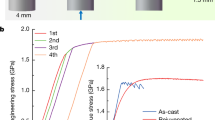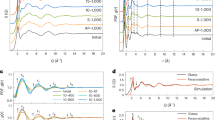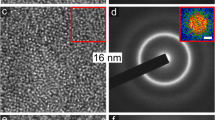Abstract
Owing to a lack of microstructure, glassy materials are inherently strong but brittle, and often demonstrate extreme sensitivity to flaws. Accordingly, their macroscopic failure is often not initiated by plastic yielding, and almost always terminated by brittle fracture. Unlike conventional brittle glasses, metallic glasses are generally capable of limited plastic yielding by shear-band sliding in the presence of a flaw, and thus exhibit toughness–strength relationships that lie between those of brittle ceramics and marginally tough metals. Here, a bulk glassy palladium alloy is introduced, demonstrating an unusual capacity for shielding an opening crack accommodated by an extensive shear-band sliding process, which promotes a fracture toughness comparable to those of the toughest materials known. This result demonstrates that the combination of toughness and strength (that is, damage tolerance) accessible to amorphous materials extends beyond the benchmark ranges established by the toughest and strongest materials known, thereby pushing the envelope of damage tolerance accessible to a structural metal.
This is a preview of subscription content, access via your institution
Access options
Subscribe to this journal
Receive 12 print issues and online access
$259.00 per year
only $21.58 per issue
Buy this article
- Purchase on Springer Link
- Instant access to full article PDF
Prices may be subject to local taxes which are calculated during checkout





Similar content being viewed by others
References
Launey, M. E. & Ritchie, R. O. On the fracture toughness of advanced materials. Adv. Mater. 21, 2103–2110 (2009).
Ritchie, R. O. The quest for stronger, tougher materials. Science 320, 448 (2008).
Hofmann, D. C. et al. Designing metallic glass matrix composites with high toughness and tensile ductility. Nature 451, 1085–1089 (2008).
Ashby, M. F. & Greer, A. L. Metallic glasses as structural materials. Scr. Mater. 54, 321–326 (2006).
Lewandowski, J. J. et al. Intrinsic plasticity or brittleness of metallic glasses. Phil. Mag. Lett. 85, 77–87 (2005).
Xu, J. et al. The fracture toughness of bulk metallic glasses. JOM 62, 10–18 (2010).
Xi, X. K. et al. Fracture of brittle metallic glasses: Brittleness or plasticity. Phys. Rev. Lett. 94, 125510 (2005).
Hess, P. A. et al. Indentation fracture toughness of amorphous steel. J. Mater. Res. 20, 783–786 (2005).
Schroers, J. & Johnson, W. L. Ductile bulk metallic glass. Phys. Rev. Lett. 93, 255506 (2004).
Suh, J-Y. et al. Correlation between fracture surface morphology and toughness in Zr-based bulk metallic glasses. J. Mater. Res. 25, 982–990 (2010).
Gu, X. J. et al. Compressive plasticity and toughness of a Ti-based bulk metallic glass. Acta Mater. 58, 1708–1720 (2010).
Inoue, A. et al. Cobalt based bulk glassy alloy with ultrahigh strength and soft magnetic properties. Nature Mater. 2, 661–663 (2003).
Conner, R. D. et al. Shear bands and cracking of metallic glass plates in bending. J. Appl. Phys. 94, 904–911 (2003).
Johnson, W. L. & Samwer, K. A universal criterion for plastic yielding of metallic glasses with a (T/Tg)2/3 temperature dependence. Phys. Rev. Lett. 95, 195501 (2005).
Bouchaud, E. et al. Fracture through cavitation in a metallic glass. Europhys. Lett. 83, 66006 (2008).
Duwez, P. et al. Amorphous phase in palladium–silicon alloys. J. Appl. Phys. 36, 2267–2269 (1965).
Chen, H. S. et al. Elastic constants, hardness and their implications to flow properties of metallic glasses. J. Non-Cryst. Solids 18, 157–171 (1975).
Chen, H. S. & Turnbull, D. Formation, stability, and structure of palladium–silicon based alloy glasses. Acta Metall. 17, 1021–1031 (1969).
Kimura, H. & Masumoto, T. Deformation and fracture of an amorphous Pd–Cu–Si alloy in V-notch bending test. 1. Model mechanics of inhomogeneous plastic-flow in non-strain hardening solid. Acta Metall. 28, 1663–1675 (1980).
Kimura, H. & Masumoto, T. Deformation and fracture of an amorphous Pd–Cu–Si alloy in V-notch bending test. 2. Ductile–brittle transition. Acta Metall. 28, 1677–1693 (1980).
Launey, M. E. et al. Fracture toughness and crack resistance curve behavior in metallic glass matrix composites. Appl. Phys. Lett. 94, 241910 (2009).
Shih, C. F. Relationships between the J-integral and the crack opening displacement for stationary and extending cracks. J. Mech. Phys. Solids 29, 305–326 (1981).
Hutchinson, J. W. Plastic stress and strain fields at a crack tip. J. Mech. Phys. Solids 16, 337–342 (1968).
Rice, J. R. & Rosengren, G. F. Plane strain deformation near a crack tip in a power-law hardening material. J. Mech. Phys. Solids 16, 1–12 (1968).
Alpas, A. T. et al. Fracture and fatigue crack-propagation in a Ni-base metallic-glass. Metall. Trans. A 20, 1395–1409 (1989).
Flores, K. M. & Dauskardt, R. H. Enhanced toughness due to stable crack tip damage zones in bulk metallic glass. Scr. Mater. 41, 937–949 (1999).
Demetriou, M. D. et al. Cooperative shear model for the rheology of glass-forming metallic liquids. Phys. Rev. Lett. 97, 065502 (2006).
Johnson, W. L. et al. Rheology and ultrasonic properties of metallic glass-forming liquids. MRS Bull. 32, 644–650 (2007).
Ashby, M. F. Materials Selection in Mechanical Design (Pergamon, 1992).
Nouri, A. S. et al. Chemistry (intrinsic) and inclusion (extrinsic) effects on the toughness and Weibull modulus of Fe-based bulk metallic glasses. Phil. Mag. Lett. 88, 853–861 (2008).
Demetriou, M. D. et al. Glassy steel optimized for glass-forming ability and toughness. Appl. Phys. Lett. 92, 161910 (2008).
Kawashima, A. et al. Fracture toughness of Zr55Al10Ni5Cu30 bulk metallic glass by 3-point bend testing. Mater. Trans. 46, 1725–1732 (2005).
Gilbert, C. J. et al. Fracture toughness and fatigue crack propagation in a Zr–Ti–Ni–Cu–Be bulk metallic glass. Appl. Phys. Lett. 71, 476–478 (1997).
Lowhaphandu, P. & Lewandowski, J. J. Fracture toughness and notched toughness of bulk amorphous alloy: Zr–Ti–Ni–Cu–Be. Scr. Mater. 38, 1811–1817 (1998).
Acknowledgements
M.D.D., G.G., J.P.S., D.C.H. and W.L.J. acknowledge support by the MRSEC program of the National Science Foundation under award number DMR-0520565 for the alloy development work. M.E.L. and R.O.R. acknowledge support by the Director, Office of Science, Office of Basic Energy Sciences, Division of Materials Sciences and Engineering, of the US Department of Energy under contract number DE-AC02-05CH11231 for the fracture-toughness characterization. The contributions of A. Wiest, J-Y. Suh, M. Floyd, C. Crewdson and C. Garland are also acknowledged.
Author information
Authors and Affiliations
Contributions
M.D.D., M.E.L., W.L.J. and R.O.R. designed the research; M.D.D. developed the alloy; M.D.D., G.G., J.P.S. and D.C.H. characterized the alloy; M.E.L. carried out the mechanical testing; M.D.D., M.E.L., W.L.J. and R.O.R. wrote the manuscript.
Corresponding author
Ethics declarations
Competing interests
The authors declare no competing financial interests.
Supplementary information
Supplementary Information
Supplementary Information (PDF 1059 kb)
Supplementary Information Movie
Supplementary Movie (MOV 888 kb)
Rights and permissions
About this article
Cite this article
Demetriou, M., Launey, M., Garrett, G. et al. A damage-tolerant glass. Nature Mater 10, 123–128 (2011). https://doi.org/10.1038/nmat2930
Received:
Accepted:
Published:
Issue Date:
DOI: https://doi.org/10.1038/nmat2930
This article is cited by
-
Toughening through faint crystallization
Nature Materials (2023)
-
Toughening oxide glasses through paracrystallization
Nature Materials (2023)
-
Fatigue database of complex metallic alloys
Scientific Data (2023)
-
Developing novel amorphous alloys from the perspectives of entropy and shear bands
Science China Materials (2023)
-
Corrosion and Mechanical Properties of Novel Fe-Based Bulk Amorphous Alloys
Journal of Materials Engineering and Performance (2023)



